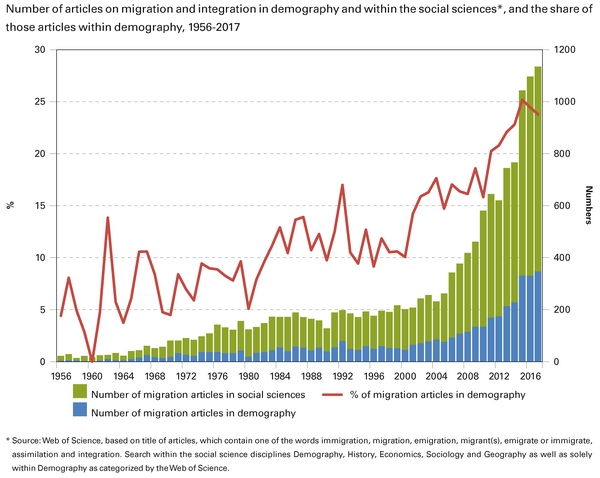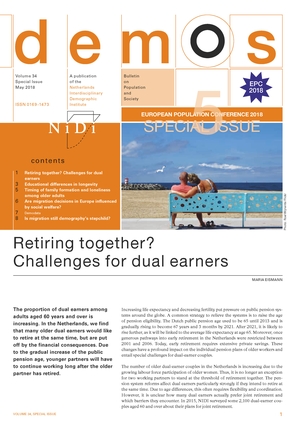HARRY VAN DALEN
Demography has for long been preoccupied with developments in fertility and mortality and its effects on population size and structure. Demography was more focused on a closed society and in the grand scheme of mathematical demography migration seemed to be a variation on a theme. Or as demographer Dudley Kirk once characterized in 1960 the status of (internal) migration research: migration is “the stepchild of demography”. But how have migration researchers fared in the recent past? Is migration research a booming industry or does it still take a backseat in demography? To seek an answer to these questions one can consult the Web of Science to track development of research over time. The figure below presents the number of scientific articles over the period 1956-2017 of which the title contained phrases concerning migration and/or integration/ assimilation. As migration is a topic studied in various social sciences, I have searched for articles within the discipline of demography as well as in the contiguous social sciences that have shown an interest in migration: history, economics, sociology and geography.

The number of articles on migration has exploded over time: in the 1950s and early 1960s, the annual number of migration and integration articles in demography journals varied between zero and nine, but the last couple of years approximately 330 articles appear yearly. As a percentage of all demography articles, migration had a share of five to ten percent and now it is approaching 25 percent. Taking a broader view of the stage for migration ideas and counting the number of articles appearing in the social sciences one can also see a strong increase starting around 2004. In 2017, 1,135 migration articles appeared in the social sciences. The corresponding share of migration articles (not show in the figure) rose from one percent to around two percent today. An important determinant of this large increase is of course the strong growth in the number of journal outlets over time. The addition of specialized and relatively young journals in the Web of Science like Journal of Ethnic and Migration Studies (established 1998) and Population, Space and Place (established in 1999) are in large part responsible for the growth spurt within demography in this century. Overall, with such a production of articles and such a large share within demography one can no longer make the claim that migration is the stepchild of demography.
However, when it comes to the most influential articles within migration the top ten articles predominantly come from outside demography: six from top economics journals, three from demography journals and one from a top sociology journal. The most influential article with 1,894 citations is the classic paper by Harris and Todaro on ‘Migration, Unemployment and Development’ in the American Economic Review (1970). A different and related question is: who are the big producers of migration ideas? When we turn to the top-5 of most productive migration researchers (in terms of articles) in the social sciences one comes across familiar names within the community of demographers: (1) Douglas Massey; (2) Oded Stark; (3) Michael Greenwood; (4) Russell King, and (5) Andrei Rogers. Except maybe for Oded Stark, all these scientists have dual allegiances: they study migration with one foot in demography and another foot in a contiguous discipline, like geography, economics, or sociology. Perhaps there is a lesson here for aspiring migration researchers.
Harry van Dalen, NIDI and Tilburg University, email: dalen@nidi.nl
References
- Kirk, D. (1960).
- Some reflections on American demography in the nineteen sixties. Population Index, 26(4), pp. 305-310.
- Van Dalen, H.P., & K. Henkens (2012),
- What is on a demographer’s mind – A worldwide survey. Demographic Research, 26(16), pp. 363-408.


